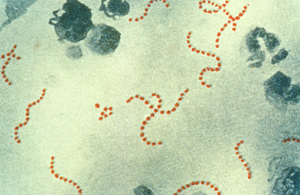High levels of scarlet fever remain across England
PHE publishes latest figures for scarlet fever notifications.

Public Health England (PHE) has reported a continuation of the high levels of scarlet fever across the country with 405 new cases reported in the last week (from 21 to 27 April). A total of 8,305 new cases have now been reported since the season began in September 2013. While data from recent weeks suggest a decline in incidence, close monitoring continues to assess the impact of children returning to school after the Easter break.
Scarlet fever is a seasonal disease and this is the time of year when we would expect to see a decline in the number of cases. Given the unusual rise in incidence seen this year, this seasonal pattern may not be observed.
PHE will continue working closely with healthcare professionals to assess the impact of the high levels of scarlet fever on the number of complications reported. Investigations also continue across the country to assess whether a new strain may have emerged.
Dr Theresa Lamagni, PHE’s head of streptococcal infection surveillance, said:
We are still observing exceptionally high numbers of cases and will continue to monitor the situation closely to see if there is a sustained fall over the coming weeks.
We strongly urge people to remain vigilant and to go to their GP if they develop symptoms which suggest scarlet fever such as a sore throat, fever, headache and rash.
Whilst scarlet fever is usually a mild illness it should be treated with antibiotics to reduce the risk of further complications. It is mainly a childhood disease, most common between the ages of 2 and 8 years, although adults can also develop scarlet fever.
Schools, nurseries and childcare settings should embed good hand hygiene practice within daily routines for pupils and staff and alert local PHE Health Protection Teams if an outbreak of scarlet fever is suspected. Children and adults should be encouraged to cover their mouth and nose with a tissue when they cough and sneeze and to wash their hands after using or disposing of tissues.
Notes to editors
- An average of 1,982 cases of scarlet fever, have been reported for the same period (September to April) in the previous 10 years (range 1038 to 3,476).
- Regional breakdowns for scarlet fever seasonal activity between September to April, England
| PHE Centre Name | Number of cases in 2013 to 2014 season (weeks 37 in 2013 to weeks 17 in 2014) |
|---|---|
| Anglia and Essex | 352 |
| Avon, Gloucestershire and Wiltshire | 656 |
| Cheshire and Merseyside | 396 |
| Cumbria and Lancashire | 361 |
| Devon, Cornwall and Somerset | 272 |
| East Midlands | 1362 |
| Greater Manchester | 394 |
| Kent, Surrey and Sussex | 555 |
| London | 762 |
| North East | 525 |
| South Midlands and Hertfordshire | 408 |
| Thames Valley | 442 |
| Wessex | 370 |
| West Midlands | 680 |
| Yorkshire and the Humber | 770 |
| England | 8305 |
- Read the latest health protection report
- Read the ‘Public health management of scarlet fever outbreaks in schools, nurseries and other child care settings’ guidance
- There is currently no vaccine for scarlet fever.
- More information on hand hygiene is available from the e-bug website
- Patient information is available from NHS Choices and PHE’s Frequently Asked Questions
- Further Information on scarlet fever for health professionals.
- Public Health England’s mission is to protect and improve the nation’s health and to address inequalities through working with national and local government, the NHS, industry and the voluntary and community sector. PHE is an operationally autonomous executive agency of the Department of Health.
www.gov.uk/phe Follow us on Twitter @PHE_uk
UKHSA press office: National Infection Service
UKHSA press office, infectious diseases
61 Colindale Avenue
London
NW9 5EQ